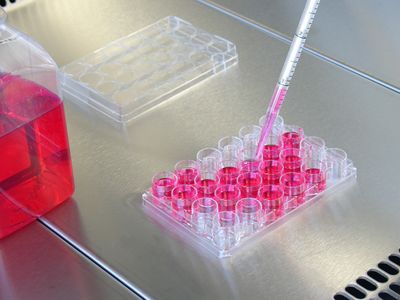ABOVE: A robotic finger covered with living skin heals after an injury thanks to a collagen bandage. Shoji Takeuchi
Baths of human skin cells might sound like something straight out of a horror movie. But in reality, having a vat of skin at the ready allowed researchers to give a mechanical finger a layered covering that looks and acts much like human skin.
“Our goal is to develop robots that are truly human-like.” Shoji Takeuchi, a study coauthor and engineer at The University of Tokyo, tells the Australian Broadcasting Corporation (ABC). On that front, the team succeeded, researchers in the field say. “This is very interesting work and an important step forward,” Ritu Raman, an MIT engineer not involved in the work, tells Science News.
To generate the skin, the researchers sunk the robotic digit in a blend of collagen and lab-grown dermal fibroblasts, a kind of human skin cells found in the dermis, the basal layer of human skin. Once a suitable layer of those cells had formed, the team added cultured human keratinocytes, which are the kind of cells that dominate the epidermal outer layer of human skin. After two weeks of cellular soaks, the robot had a dual-layered “skin-equivalent” that was approximately 1.2-millimeter-thick—eerily similar to the 2-millimeter-thick skin found on human fingers, the team reported yesterday (June 9) in Matter.
When the finger bent, the skin stretched with it. It was even able to heal: when the researchers cut the skin and then covered the wound with a collagen bandage, the layers stitched themselves together and, after about a week, the wound was no longer visible.
Such advancements toward more humanlike robots can, researchers say, help make people more comfortable around the mechanical creations and imbue them with especially useful skills. “It’s important that robots are able to effectively interact with a human-built world,” Nicole Robinson, a scientist who specializes in robot-human interactions at Monash University in Australia who was not involved in the study, tells ABC.
“I think living skin is the ultimate solution to give robots the look and touch of living creatures since it is exactly the same material that covers animal bodies,” Takeuchi tells Newsweek.
The skin equivalent isn’t yet ready for regular use. It lacks any form of circulatory system, so it needs to be submerged in a nutrient broth to stay alive and not dry out. It also wasn’t a perfect skin mimic because it lacked components such as nerves, hair, and sweat glands.
Just give the team a bit more time, says Takeuchi. “In the future, we will develop more advanced versions by reproducing some of the organs found in skin, such as sensory cells, hair follicles, and sweat glands,” he says in a press release.
The team may even incorporate pigment cells to give the skins more humanlike colors, he tells New Scientist. “But since this research field has the potential to build a new relationship between humans and robots, we need to carefully consider the risks and benefits of making it too realistic.”





